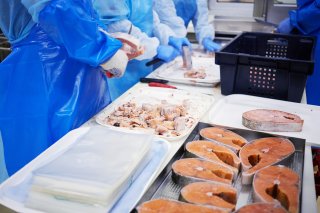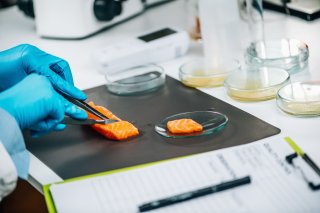Eat Fish and Shellfish in a Healthy Way
Avoid Food Poisoning from Eating Fish or Shellfish

The food supply in the United States is among the safest in the world. However, when certain disease-causing bacteria or pathogens contaminate food, they can cause foodborne illness, often called "food poisoning." Although everyone is susceptible, some people are at greater risk of developing foodborne illness.
To avoid foodborne illness, people who are pregnant, young children, older adults, or people with weakened immune systems, are advised not to eat:
- Raw fish
- Partially cooked seafood (such as shrimp and crab)
- Refrigerated smoked seafood, except in a cooked recipe such as a casserole. Refrigerated smoked seafood (such as salmon, trout, whitefish, cod, tuna, or mackerel) is usually labeled as “novastyle,” “lox,” “kippered,” “smoked,” or “jerky.” Canned or shelf-stable smoked seafood is acceptable.
- Raw shellfish (including oysters, clams, mussels, and scallops) or their juices
Select and Serve Fresh and Frozen Seafood Safely
The Food and Drug Administration (FDA) has developed basic food safety tips for buying, preparing, and storing fish and shellfish to help you and your family safely enjoy the benefits and good nutrition of seafood. The Centers for Disease Control (CDC) has information on avoiding food poisoning from fish and shellfish.
- Selecting and Serving Fresh and Frozen Seafood Safely - FDA
- Food Facts - FDA
- Food Safety in Your Kitchen - FDA
- 4 Steps to Food Safety - CDC
Avoid Eating Too Much Contaminated Fish

The following advice may help you avoid long-term health effects from contaminants, such as mercury, that can build up in your body over time.
EPA-FDA Advice about Eating Fish
This advice is for those who might become pregnant, are pregnant or are breastfeeding as well as parents and caregivers who are feeding children. It can help you make informed choices for fish purchased from grocery stores and restaurants.
State, Territory and Tribal Advice about Eating Fish
All 50 states, and some Tribes and U.S. territories, monitor for contaminants in fish in their waters and issue consumption advisories and/or safe eating guidelines. These help people reduce or avoid potential long-term health risks from eating contaminated fish by recommending how often they can eat certain species of fish caught in certain places.
Addressing Shellfish Contamination
Some state health departments test shellfish harvested within their jurisdictions to monitor toxin levels and assess the risk for contamination. Depending on the results of such testing, recreational and commercial shellfish harvesting may be prohibited locally during periods of risk.
State and federal regulatory agencies also monitor reported cases of toxin poisoning to marine life, for example harmful algal blooms (HABs), and health departments investigate possible outbreaks and devise control measures.
The EPA is part of the Interstate Shellfish Sanitation Conference (ISSC), which issues Notices of Illness Outbreaks, Shellfish Closures, Re-openings, and Recalls. The ISSC was formed to foster and promote shellfish sanitation through the cooperation of state and federal control agencies, the shellfish industry, and the academic community. The National Shellfish Sanitation Program is the federal/state cooperative program recognized by the ISSC for the sanitary control of shellfish produced and sold for human consumption. The program exercises sanitary control over all phases of growing, harvesting, shucking, packing, and distribution of fresh and fresh-frozen uncooked oysters, clams, mussels and scallops.
